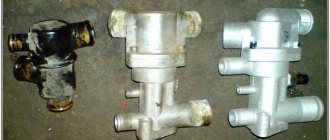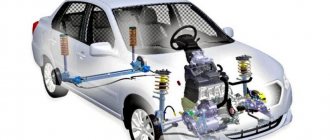As you know, modern cars use a special liquid to cool the power plant. The versatility of this option allows you to simultaneously provide interior heating in winter.
In order for this system to work properly, a special device called a thermostat is also installed in it. In another way, it is also called a coolant temperature regulator. One of its functions is to help the engine warm up as quickly as possible and maintain it in the required condition.
In this article we will talk about how the thermostat of a Grant car is converted to a higher response threshold (92 degrees). In addition, we will tell you about the principle of operation of this device and about possible problems that arise in it.
general information
There are single-valve, two-stage and two-valve thermostats, as well as electronically controlled devices. Grants are equipped with thermostats Luzar LT0191 and Luzar LT0190 (costing from 450 rubles for the first, and from 800 rubles for the second), FENOX TS034E7 (costing from 800 rubles), VAZ-2123 (article 2123-1306010, cost from 650 rub.). It is worth mentioning such devices as VAZ-2101 GATES (article TH14580, cost - from 350 rubles), VAZ-2121 GATES (article TH15380, approximate cost - from 500 rubles), VAZ-2110 (article 21082-1306010, cost - from 600 rub.) and other devices. They are located between the engine and the radiator, but it should be noted that there are differences in the location of the thermostats on Grants with eight-valve and sixteen-valve engines.
Their main task is to prevent the movement of antifreeze through the radiator until the car engine warms up to the required temperatures. Accordingly, if the car engine does not warm up, then the coolant does not move in a large circle. Usually the thermostat is activated when the engine reaches a temperature of 80-95C. Among other things, the thermostat helps reduce the amount of harmful emissions released into the atmosphere and minimize engine wear.
The thermoelement located inside the device is made of brass, has a cylindrical shape and is filled with artificial wax. When the engine reaches a temperature of approximately 82C, this substance begins to melt, which causes it to expand. This sets the valve in motion, it opens, after which the antifreeze begins to circulate through the car’s radiator. Turning off the motor causes the wax to solidify inside the thermostat and close the damper.
Website about joints
Recently, the engine has stopped reaching normal temperature, the maximum limit is 78 - 80 degrees (although according to the passport it should be 85 degrees) Since the thermostat on my car has already been changed once under warranty, I decided not to buy the same one...
The topic is not new, you can take it apart thermostat and install a thermocouple from AUDI into it. Wahler 3091.92D (92 degrees) is ideal for our “thermos”
and
Wahler 3017.87D (87 degrees)
.
I ordered a thermostat on the Exist Wahler 3017.87D. Basically everyone sets it to 92 degrees, but I think in the summer there will be problems...
I received this box. All you need from the thermostat itself is a thermocouple and a spring...
code Luzar LT 0192
OEM number: 2190-1306010-92 2190-1306010 21200-5PA0A 2190-1306100
Opening temperature, ?С: 92
Where can I buy
Applicability for vehicles
Brand name – LT – LuzarThermostat
Thermostats are necessary to direct the flow of coolant in the cooling system of automobile engines, thereby regulating the temperature of the coolant.
- when the temperature rises (usually at ≈80ºC), the main thermostat valve opens while the bypass valve closes;
- the radiator is included in the cooling circuit;
- the coolant temperature drops;
- When the temperature decreases, the reverse process occurs.
If necessary. more details
Brand name – LT – LuzarThermostat
Thermostats are necessary to direct the flow of coolant in the cooling system of automobile engines, thereby regulating the temperature of the coolant.
- when the temperature rises (usually at ≈80ºC), the main thermostat valve opens while the bypass valve closes;
- the radiator is included in the cooling circuit;
- the coolant temperature drops;
- When the temperature decreases, the reverse process occurs.
If you need to purchase a thermostat for a car, you need to know a few simple rules.
The operation of a car thermostat is characterized by two parameters:
The service life of a car thermostat depends on the degree of professionalism of the manufacturer and depends on the following points:
- thermostat designs
- pairing parts
- production technologies
- technical production capabilities
- raw materials used
- level of control of finished products
In turn, the accuracy of the auto thermostat is “revealed” by several indicators:
- opening temperature
- opening speed
- valve lift
- pressure at which the valve seals when closed
Signs of breakdown
The thermostat is a fairly simple element, however, and it is not immune to breakdowns. Normally, after starting a cold engine, the lower hose extending from the radiator does not heat up for some time, but after the coolant temperature exceeds 85C (±2C), it begins to quickly heat up (provided the thermostat is in full working order). It is this aspect that will accurately indicate to the car owner the moment the coolant begins to circulate.
In cases where the valve cannot open, the coolant stops circulating and the engine begins to overheat. Overheating also causes incomplete opening of the valve. A delay in closing the valve, on the contrary, creates conditions for a longer warm-up of the engine, especially in the cold season.
As a rule, thermostat failure is caused by the following reasons:
Most often, a malfunction of the thermostat leads to the impossibility of further movement in the car, and therefore the faulty part must be replaced immediately.
Scheme of the large and small circle of circulation
Typical faults
| Name | Diagnostics | Elimination |
| Motor overheating | Insufficient antifreeze level Depressurization of the structure Regulator malfunction Clogged radiator, lines | Replenish the missing amount of antifreeze. Replace rubber seals. Clean the fluid supply channels |
| Excessive hypothermia of the power unit | The regulator is faulty -/- drive unit -/- temperature sensor | Replacement of the thermostat, drive, temperature sensor with a new one. |
| Liquid leak | Deformation of pipes Third party mechanical damage Deformation after an accident, impact, collision Burnt out cylinder block gasket | Replacement of rubber pipes with new ones. Replacing the sealing gasket. |
| Antifreeze leak inside the water jacket | Deformation of the block gasket Burnout of the gasket | Replacing the gasket, carrying out a complete disassembly of the block, troubleshooting, replacing worn elements |
Related link:
Test drive - LADA Granta Sport 2018
Instructions for replacing a faulty element
Dismantling work begins with draining the coolant. Then you need to free access to the thermostat, which will require removing the air filter. You should also remove the hose that supplies air to the throttle assembly. After this, you will press the lock of the block with the wires of the motor control system and disconnect the block.
The next step is to unscrew the nut attaching the tip of the “mass” wire to the thermostat and remove it. Then the tightening on the fastening clamp of the supply hose is loosened, after which it is removed from the pipe. The hose supplying fluid to the heater radiator is also disconnected in the same way.
Next, the nuts securing the thermostat housing itself are unscrewed, after which the housing is removed. The place where the housing connects to the cylinder heads is always sealed with a gasket. Therefore, unscrew the screws that secure the thermostat cover and remove it. In addition, a rubber ring seals the place where the lid is connected to the body. By pressing the locking plate with pliers and carefully turning it in different directions, remove this element from engagement with the protruding parts of the body. Then you need to remove the thermostat spring, after which the cylinder is removed from the thermostat.
How does the Lada Granta cooling system work?
- Radiator: serves to cool the liquid through air flow.
- Expansion tank: compensates for insufficient fluid when operating temperature changes. Secondary function: filling the system with antifreeze.
- Pump (pump): drives the fluid inside the system.
- Thermostat: ensures the optimal temperature of the cooling system by directing the flow of liquid in a large/small circle.
- Temperature sensor: signals the driver about the current degree of antifreeze.
Carrying out an inspection
The process of checking the thermostat is a relatively simple procedure. To begin, the removed thermostat bottle is lowered into a transparent container into which coolant has previously been poured. Next, this container is heated, periodically stirring the coolant and monitoring with a thermometer the moment when the cylinder rod begins to move. When the coolant reaches a temperature of 85C (±2C), the rod of a fully working device will begin to extend. When the liquid in the container is heated to 100C (±2C), it will extend completely.
Advantages of LUZAR thermostats
- Computer dosage of thermal wax LUZAR thermostats have thermal sensors filled using special equipment, which guarantees high accuracy of operation.
- Patented thermal sensor design To eliminate the possibility of a “breakthrough” of thermal wax from the thermal sensor body (which, according to statistics, is the most common cause of thermostat failure), LUZAR changed the configuration of the sealing gasket in the rod-thermal wax-cylinder interface. With increasing pressure, which expands when heated, the thermal wax gasket design - thanks to its specific geometry - forms an increased volume of rubber precisely in places where the thermal wax “breakthrough” may occur. This also required changing the geometry of the temperature sensor housing (“cylinder”).
- Rubberized valves We have eliminated the cause of insufficient tightness of the thermoelement - the metal-to-metal interface between the metal frame of the thermoelement and the metal valve plate - by using a rubber sealing gasket on the valve plate. Thus, LUZAR thermostats provide faster engine warm-up in winter (which is so important in Russian conditions climate).
- 100% control of thermoelements Each thermoelement is tested for temperature, height and response speed - carried out in special baths with cells.
- Warranty 2 years or 125,000 km. Mandatory certification In the event of a breakdown, you can easily replace the purchased thermostat through a retail store - just return it with a warranty card and a description of the defect. All products are certified according to the international quality management system ISO 9001 TUV and have GOST-R certificates of conformity.
Replacing the thermostat from 77C to 92C
Many Grant owners complain about rather problematic and weak thermostats in their cars. Most of the complaints are related to the fact that the device allows access to antifreeze after the engine has warmed up to 80C. In fact, there is no malfunction in this, it’s just a feature of the operation of specific engines - they are initially configured to operate at this temperature.
Most often, such features are not taken seriously by car owners, and do not interfere with the functioning of the engine. Perhaps the only noticeable difference will be cooler air inside the car at sub-zero temperatures outside. However, converting the car to gas fuel will significantly complicate this situation.
ATTENTION. For some AVTOVAZ engines, a temperature of 77-80 degrees Celsius is the operating temperature. There is no need to change the thermostat as it is working properly.
In such circumstances, the element can be modified, although not recommended by the manufacturer, after which it will open at 92C. The modification will require the purchase of a new thermostat, however, replacing the entire part will not be necessary; all you need from the new thermostat is a sensor.
To carry out this work you will need:
- drive the car onto a ramp or into a pit;
- drain the antifreeze;
- remove the air duct (it will interfere with the work process);
- dismantle the thermostat (or simply remove the cover from the device without losing the seal);
- install a new thermoelement;
- press the thermocouple with a spring and a limiter.
As a result of the above manipulation, the response temperature will increase by approximately 15%.
Design of LUZAR thermostats
The terms should be distinguished:
- thermostat in a broad sense (car part, thermostat in a housing, thermostat as a “function”)
- thermostat in the “commodity” sense (a replaceable part of the thermostat, can be either a thermostat in the housing or a thermoelement; what is sold as a thermostat for a given machine)
- thermoelement (“working” part of the thermostat, in some cases may coincide with the name of the thermostat in the “commodity” sense)
- temperature sensor (the executive part of the thermostat is part of the thermoelement; it is a brass cylinder with a filler that expands when heated)
An automobile thermostat consists of a temperature sensor, which is a brass cylinder with a filler (technical paraffin or thermal wax), which expands when heated, with a rod on which spring-loaded plates of the main and bypass valves are placed; the temperature sensor is rigidly fixed to the frame, through which the thermoelement can be installed in the thermostat housing. The valve discs have rubber seals.
Automotive thermostats can be cased or uncased, depending on the design laid down by the designer of the engine.
Design image
- modern automotive industry, with the increasing complexity of automobile engines, is switching to the use of electronic thermostats, where temperature control is carried out by sensors, and the thermostat valves are controlled by micromotors (LUZAR does not produce electronic thermostats)
- Many modern engines have not one, but two or more thermostats - for non-uniform temperature control in different parts of the engine.











